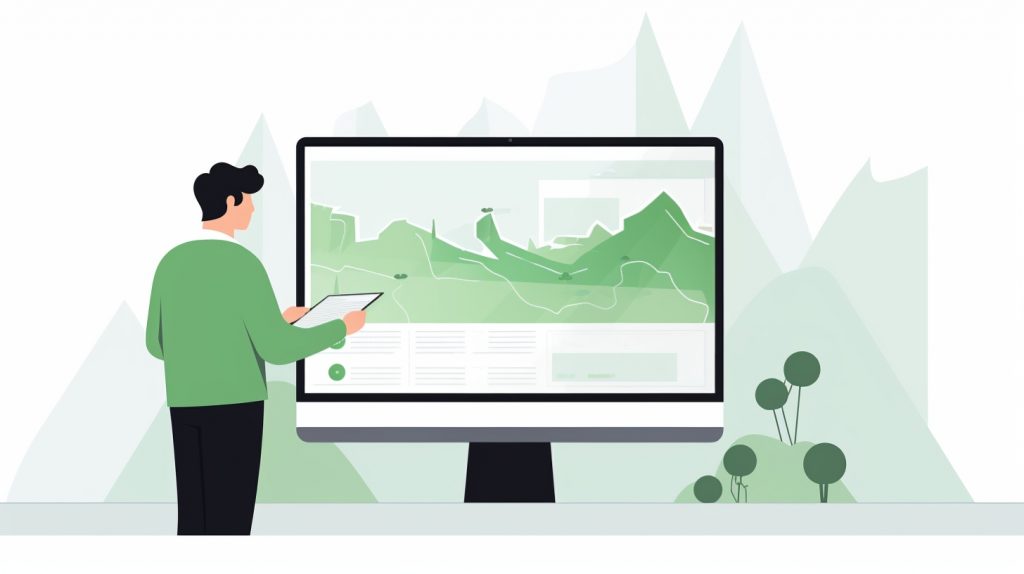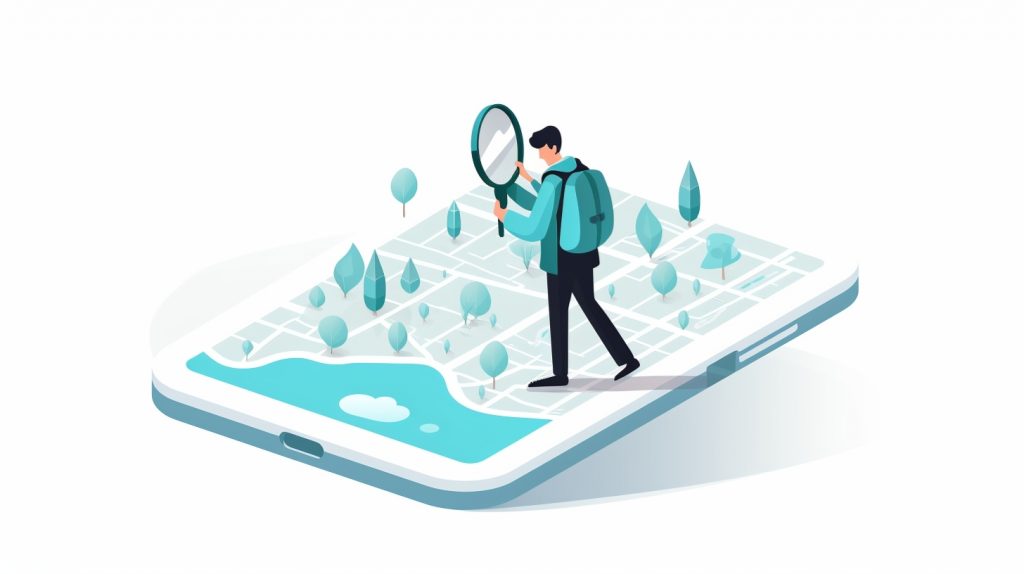Location-based services are the hidden glue that binds social networks, eCommerce platforms, and delivery apps together. From getting directions to finding nearby stores, it has revolutionized people’s interactions with their surroundings.
According to the Research and Markets report, the location-based services market will surpass $73 billion by 2026, registering an astonishing 22% annual growth. And it’s no surprise as numerous businesses in various niches opt for location-based app development to provide tailored customer experience and boost their sales.
If you want to reach new heights by leveraging geolocation technologies in your software, keep reading this post. Wellnuts, a reliable vendor delivering GIS (Geographic Information Systems) solutions, will guide you through the entire location based app development process step by step.

What Is a Location-Based App?
When you hear about location-based apps, what comes to your mind first? Your primary associations might include Google Maps, Uber, or Foursquare, where geolocation tech is the core functionality. However, in reality, location-based applications have significantly broader use.
But let’s back up for a second and define the term itself.
A location-based app is a web or mobile solution that uses GPS or other geolocation technologies to determine a user’s location and provide location-specific information, services, or features.
How does such an application work?
When a user opens an app on their device, it leverages GPS technology to retrieve the user’s location info. This data is processed to provide the information a user needs, such as local events or directions to a destination.
For instance, a location-based app for food delivery may require a user’s location to recommend nearby restaurants and show delivery options in their area. Similarly, a ride-sharing application may connect riders with drivers in their area.
Types of Location-Based Apps
As mentioned above, location-based app development doesn’t necessarily involve creating mapping or ride-hailing applications. Many other app types leverage this technology, including the following ones.
Social Apps
It’s not a very obvious example of applications that use geolocation technologies. Most often, it’s an optional feature. So users can turn it on or off when necessary. Thanks to this functionality, users can connect with others in their area or share their location. Some well-known examples of social apps involving geolocation are Facebook, Twitter, and TikTok.
Dating Apps
Most dating applications leverage geolocation technology, as well. Thus, users can find potential partners in their area. Some examples of such apps include Tinder, Bumble, and Hinge.
Fitness Apps
These apps track users’ physical location and activities to provide personalized workout recommendations based on their area and fitness goals. These are Fitbit, Nike+ Run Club, and MyFitnessPal, to name a few.
Travel Apps
With travel apps, users can plan their trips and navigate new locations. They provide information on local attractions, restaurants, and hotels. For example, these are TripAdvisor and Airbnb.
eCommerce Apps
These apps use geolocation technology to inform users about nearby stores, products, and promotions. Some store owners can even leverage this functionality to suggest tailored recommendations following their customers’ preferences. The most well-known examples of such apps are Amazon, eBay, and Walmart.
Mapping Apps
Location-based functionality is the core of mapping apps. Such solutions provide detailed maps and navigation features. With their help, users can find their way around a new location. Famous examples include Google Maps, Apple Maps, and Waze.
Delivery Apps
With delivery applications, users can order the delivery of food, groceries, and other products. Such apps also track drivers’ locations and give users real-time updates on their delivery statuses. The most famous examples are Uber Eats, Grubhub, and Postmates.
Fleet Management Apps
These apps use location-based technology to monitor and manage fleets of vehicles in real-time. Businesses use them to track their assets and find the most efficient routes.
An example of such software is a fleet management system developed by Wellnuts. We used IoT, M2M, and geolocation technologies to deliver a comprehensive platform. Here are its primary features:
- Driver portal for monitoring the fleet park
- Management portal for processing accounts and orders
- Android and iOS mobile apps for building and optimizing routes
The fuel expenses of the client decreased by 20% after implementing our fleet management solution. Overall, the fleet maintenance costs fell by 40%.

Advantages of Location-Based App Development for Businesses
Businesses gain numerous benefits from location-based mobile app development. Let’s look at the most significant ones.
Improved Shopping Experience
Geolocation tech provides eCommerce and other businesses selling products and services with a better understanding of customers’ shopping habits and preferences. For example, you can track a user’s location and purchase history. Moreover, geolocation solutions enable personalized recommendations and offers, improving the customer experience and driving sales.
Better Client Communication
With the help of location-based apps, businesses can communicate directly with customers. For instance, they send personalized messages and notifications based on users’ locations. Companies can also use geolocation as an extra communication channel. It involves reading customer reviews and putting destinations on a map. Thus, businesses can build stronger client relationships and increase user engagement.
Accurate Location
Geolocation apps accurately track the location of business assets, employees, or inventory in real-time. As a result, this approach improves efficiency and reduces costs.
Virtual Tours
Location-based apps provide users with virtual tours of a business’s location or products, making their experience more immersive. This way, companies can showcase their goods or services and attract new customers.
Relevant Offers
Geolocation apps can provide users with real-time offers and promotions based on location and interest, increasing purchase probability.
Key Features of a Location-Based App
Before you learn how to create a location based app, let’s dive deeper into the core features of such applications.
Maps
Geolocation apps usually offer interactive maps. They allow users to view their current location and explore nearby places.
Directions
Your location-based app must include turn-by-turn directions. With their help, users can navigate to their desired location on foot, by car, or using public transport.
Location Sharing
Users may need to share their location with friends or family to coordinate and stay in touch.
Local Search
Geolocation apps typically offer local search functionality. Therefore, users can discover nearby businesses, attractions, or events based on their interests.
Notifications
The local search capability is a common geolocation app feature that shows nearby establishments, attractions, or events depending on users’ preferences.
Personalized Suggestions
Location-based apps often use data analysis to provide personalized recommendations based on users’ location, behavior, and preferences. That may include tailored suggestions on product purchases or travel destinations.
Information Filter
Thanks to this functionality, people can screen their search results based on specific criteria, such as distance, rating, or price range, to find what they are looking for in no time.
Reward Programs
You can also offer rewards programs like loyalty points or discounts. They boost customers’ loyalty and engagement with businesses.
Location-Based AR
Geolocation apps may incorporate location-based augmented reality (AR) features, such as virtual guides or interactive functionalities, to make the user experience more immersive.
Other Services Integration
You can also integrate other services in your location-based app. These may include weather forecasts, social sharing buttons, etc. Such integrations provide users with more relevant and accurate information.

Location-Based Technologies You Should Know About
Before delving into location based mobile app development, let’s talk about the geolocation technologies involved. These techs aim to identify a device’s location in real-time using various methods. Let’s explore those in greater detail.
Outdoor Geolocation Technologies
Here are the most common technologies to track users’ location when they are outside.
GPS
GPS (Global Positioning System) is a satellite-based geolocation tech that leverages a network of satellites to determine a device’s location. It’s common for outdoor environments with a clear sightline.
Cell ID
Cell ID is a geolocation tech that utilizes cell towers’ data to identify a device’s location. It’s less accurate than GPS but is still helpful in urban environments, where GPS signals are often obstructed.
A-GPS
A-GPS (Assisted GPS) is an enhanced GPS version. It uses cell tower and Wi-Fi network information to identify a location, improving accuracy and speed.
Wi-Fi
Wi-Fi geolocation tech uses nearby access points for determining and tracking a device’s location. It’s more accurate than cell ID but requires a reliable Wi-Fi signal.
Indoor Geolocation Technologies
Now let’s have a look at the geolocation technologies often used to track a device’s location inside a building.
Geofencing
Geofencing is a location-based technology that uses GPS, Wi-Fi, or cellular data to create a virtual boundary around a physical location. It can trigger location-based actions, such as sending a notification or unlocking a door when a device enters or exits the marked perimeter.
iBeacon / Eddystone
Developed by Apple and Google, respectively, iBeacon and Eddystone are indoor geolocation techs that use Bluetooth Low-Energy (BLE) beacons. With its help, they transmit signals to nearby devices. These beacons can be placed in specific locations to trigger location-based actions like sending a coupon or providing directions.
How to Create a Location-Based App
How can a startup create a location-based app? Here’s a step-by-step explanation.
1. Research the Market
The first step in location-based app development is to explore the market and identify potential competitors. Conduct market research to understand what features users want and what challenges other apps face. Thus, you will determine your product’s unique value for end users.
2. Define Key Features
Once you clearly understand the market and user needs, determine the core features of your location-based application. Remember that your app’s functionality should align with your target audience’s requirements.
3. Select the Tech Stack
Select the appropriate tech stack that supports your app’s functionality. Consider the platform suitable for your app, such as iOS or Android. Also, select the programming language, development framework, and database management system.
4. Deliver App Design
Create a user-friendly design that fits your brand and app functions. Think about the overall look and feel, user navigation, and location-based data adoption. Finally, it’s essential to ensure your design is intuitive.
5. Ensure Data Safety
Implement appropriate security measures to protect user data. For instance, use encryption protocols, firewalls, and other means to prevent unauthorized access. On top of that, the app should meet data privacy laws and regulations.
6. Build an MVP
Once you have the app design and tech stack, it’s time to build a minimum viable product (MVP). It’s a simplified app version comprising only the essential features required for a successful launch. With its help, you can test the application’s basic functionality, user interface, and UX.
7. Test Your App and Fix Bugs
After building the MVP, thoroughly test the app to ensure everything works properly. This process involves several steps, including functional, performance, and usability testing. Once you have identified any issues or bugs, your team should fix them before the app’s launch.
8. Launch Your Location-Based App
Upon testing and fixing bugs, you are ready to release the app. At this stage, you need to monitor user feedback and analytics to identify any issues or areas for improvement. Regular updates will keep users engaged and increase the app’s success.

Wrapping Up
Location-based app development has become essential for businesses aiming to increase sales, improve customer engagement, and provide personalized experiences. With the right features, design, and technology, geolocation-enabled applications can help companies succeed.
If you want to build a location-based app, the process may seem daunting. But it can be a smooth and rewarding experience with the right tech partner. At Wellnuts, we have the expertise to deliver such a product for you. Contact our team, and we will guide you through each step to ensure your location-based app is a hit.
Ready to talk? Contact us: ask@wellnutscorp.com




Share Your Thoughts